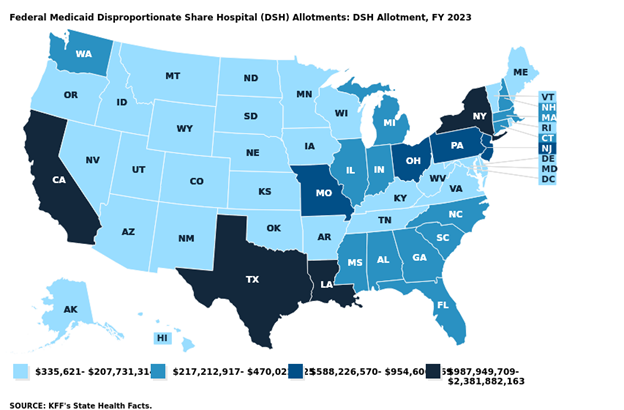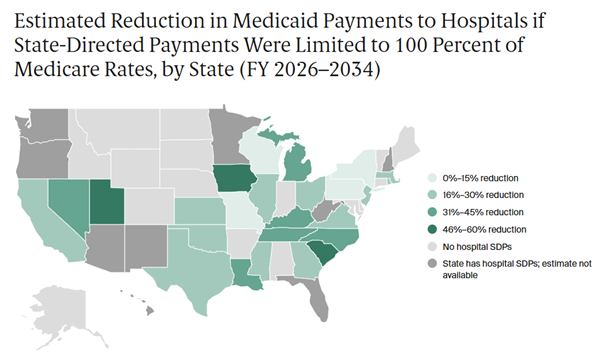24 billion in Payment Reductions
On October 1, $8 billion reductions in Disproportionate Share Hospital (DSH) payments went into effect. Additional reductions are expected in January 2026 and January 2027, totaling $24 billion. DSH payments will return to normal levels in 2028, at around $16 billion annually.1 The American Hospital Association and others sent letters requesting a delay because of the timing with H.R.1, also known as the One Big Beautiful Bill Act (OBBBA), highlighting how Congress has passed delays for nearly a decade.2
Hospitals and provider networks are largely focused on H.R.1 because of the changes to Affordable Care Act (ACA) subsidies, Medicaid work requirements, physician taxes, state-directed payments (SDPs), and the Rural Health Transformation Program (RHTP), but DSH payment reductions could be similarly impactful.
Background
DSH payments started in 1981 to support safety-net hospitals delivering care to uninsured and low-income patients, growing over time.3 In 2010, legislators passed DSH reductions because they expected higher levels of health care coverage following the ACA. Those reductions were repeatedly delayed as DSH payments still support health care providers to tens of millions of uninsured.4
SDPs were created in 2016, giving states more flexibility in directing federal reimbursements.5 States began to use SDPs to enhance Medicaid managed care rates up to commercial rates. States capitalized on that flexibility by boosting low Medicaid payments and encouraging value-based care programs. Starting July 4, new SDPs are limited to Medicare rates or lower (except for the 10 states who haven’t expanded Medicaid, then it’s 110% of Medicare rates).6
While DSH and SDPs are different in both purpose and method, they impact similar hospitals and provider networks.
Dual Pressures
Consider the two maps below, showing the state-by-state impact of SDPs and DSH payment reductions. Hospitals have been preparing for DSH payment reductions for years, but the timing with the OBBBA will make it more difficult. Even though DSH reductions were not part of OBBBA, they have become part of its economic timeline. While the RHTP applications are due November 5, $8 billion in DSH reductions were effective October 1 with another $8 billion again in January 2026.
DSH payment reductions will impact safety net hospitals and hospitals providing care to vulnerable patient populations, while SDP cuts will impact value-based care networks and hospitals with a high Medicaid payer mix.
Next Steps
Health care facilities can take steps to mitigate the risk by projecting DSH exposure through FY 20287; providers serving large Medicaid populations, especially rural providers and providers serving large pediatric populations will need to be especially attentive to these financial impacts.
Maps
These maps illustrate the similarities and differences between DSH and SDPs. Kaiser Family Foundation tracks DSH payments amounts each state receives.8 The Commonwealth Fund projects the impact of limiting new SDPs to 100% of Medicare rates instead of the prior commercial levels.9


Key Takeaways
- $24 billion in DSH reductions coincide with H.R.1 changes to SDPs.
- DSH and SDPs are different in method and purpose but support similar healthcare providers.
- Providers – especially rural and pediatric hospitals – should make strategic plans to mitigate risk.
- State by state impacts vary, as shown by maps from KFF and the Commonwealth Foundation.
This blog post was drafted by Kaleb Rasmussen, an attorney in the St. Louis, Missouri office of Spencer Fane. For more information, visit www.spencerfane.com.
—
1 Federal Medicaid Disproportionate Share Hospital (DSH) allotments: KFF State Health Facts. KFF. (2025, September 12).
2 AHA, National Hospital Groups Urge Congress to prevent Medicaid Dsh Cuts: AHA. American Hospital Association. (2025, September 5).
3 Reform needed for Medicaid DSH. Committee for a Responsible Federal Budget. (2024, December 5).
4 U.S. Uninsured Rate Drops by 15% Since 2020. CDC. (June 24, 2025).
5 Directed Payments in Medicaid Managed Care. MACPAC. (October 2024).
6 How Medicaid State-Directed Payments Support Critical Health Care Providers. The Commonwealth Fund. (July 3, 2025).
7 Health Law Navigator: OBBBA’s Medicaid Impact and Strategies for Hospitals and Health Systems. Zachary Fairlie and Donn Herring. (September 17, 2025).
8 Federal Medicaid Disproportionate Share Hospital (DSH) allotments: KFF State Health Facts. KFF. (2025, September 12).
9 How Medicaid State-Directed Payments Support Critical Health Care Providers. The Commonwealth Fund. (July 3, 2025).
Click here to subscribe to Spencer Fane communications to ensure you receive timely updates like this directly in your inbox.
